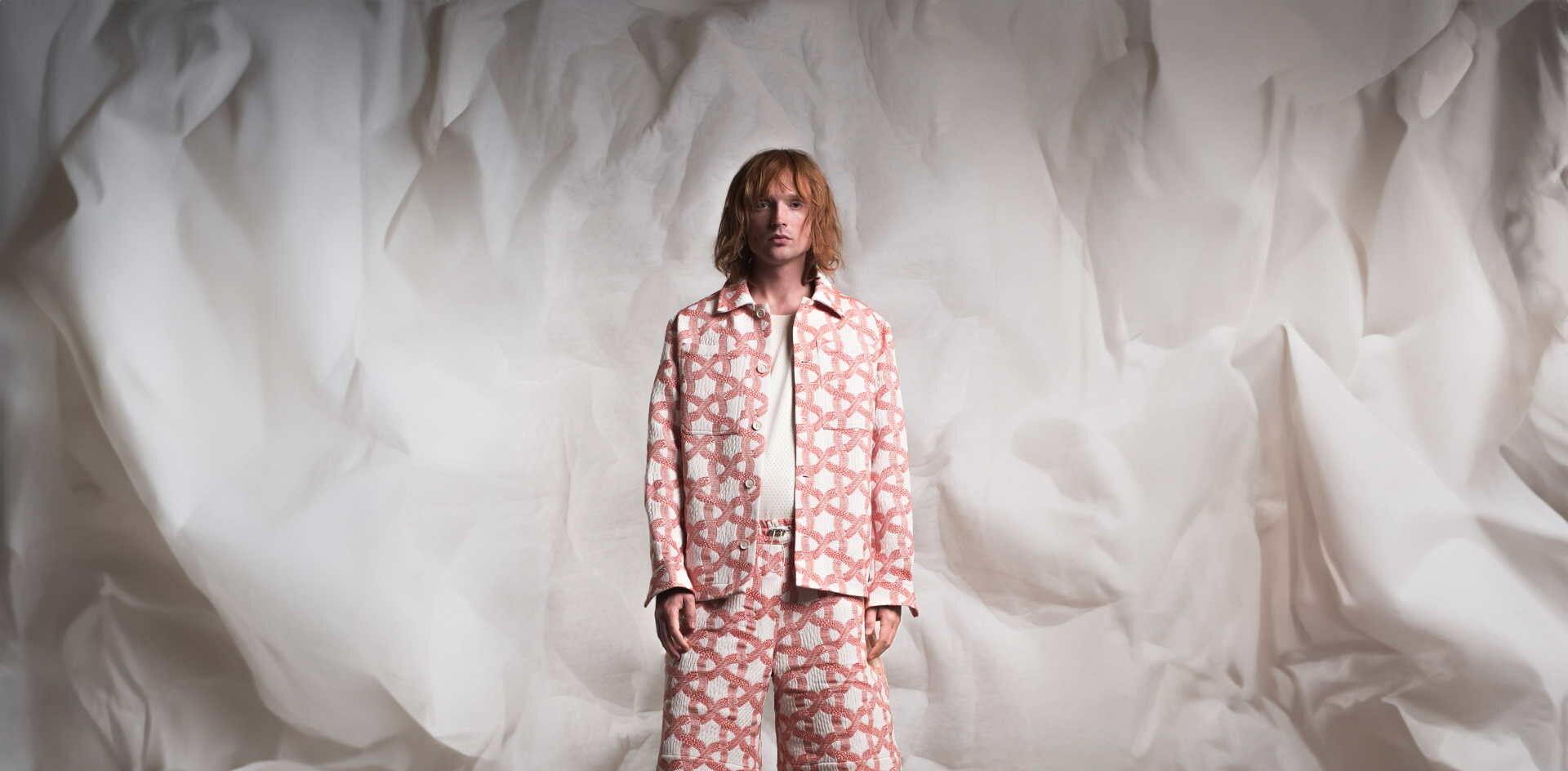
The Conscious Man | Sustainable Styles at Pitti Uomo 104
Maybe customers still fail to link their buying behaviors to the environmental disasters, but Pitti Uomo 104 has shown that eco-conscious styling is becoming more and more important in the offer of modernist brands for men. Enjoy the most advanced collections we discovered during the fair.
We arrived in Florence on the day of Silvio Berlusconi’s death.”Fashion is a language that creates desires, emotions, and dreams. It is an art form that reflects the beauty and creativity of a nation” – he said one day long time ago. With it in mind, we headed to Pitti Uomo 104, the most inspiring and powerful men’s fashion fair on the international circuit.
As soon as we arrive, Berlusconi’s voice echoes in our minds. Classic Italian men’s style is spiced up with fresh details, such as neck scarfs, straw hats and brown vintage leather bags in multiple shapes and sizes. Linen total looks in one color, classical shorts, mix of prints… The atmosphere is festive. The event is in full swing. Buyers from all over the world are looking for new collections for their shops. Influencers, photographers and journalists are witnessing again the joy of fashion. Inspiring, creative and with a stronger focus on eco-conscious collections, the Pitti Uomo 104th edition begins, promising a major breakthrough in sustainability.
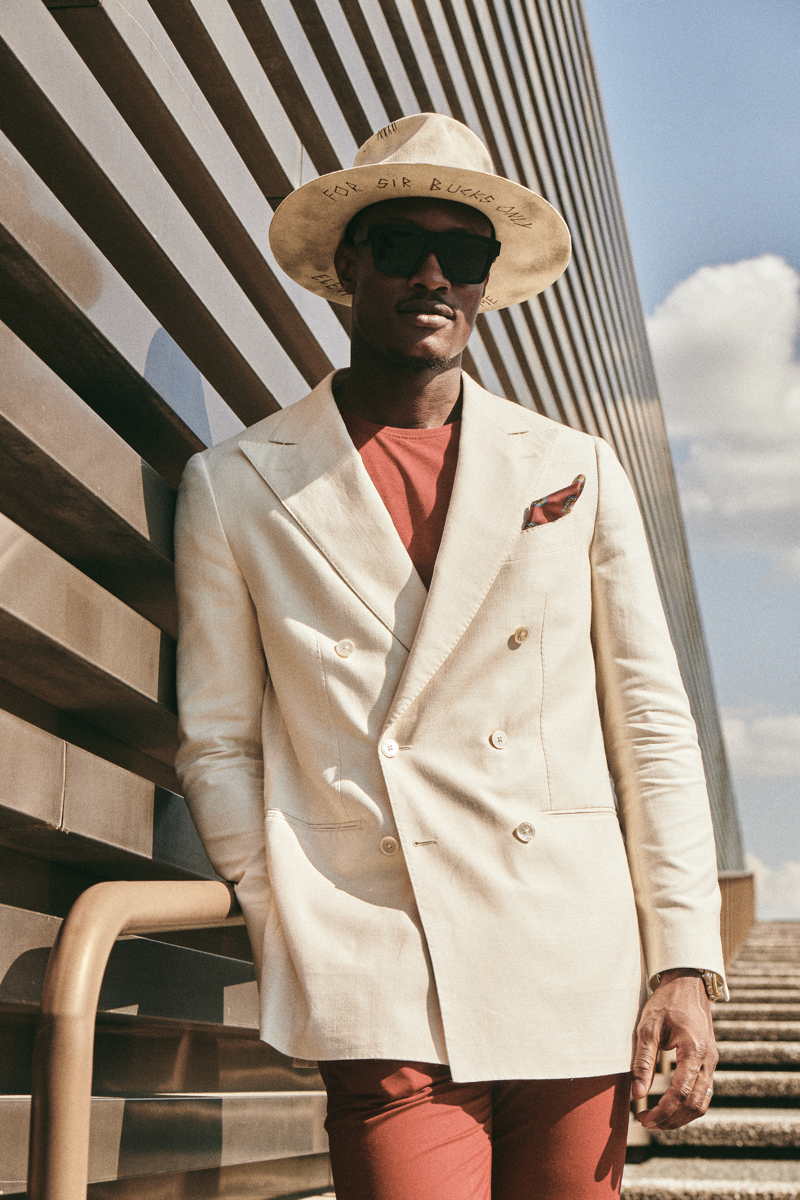


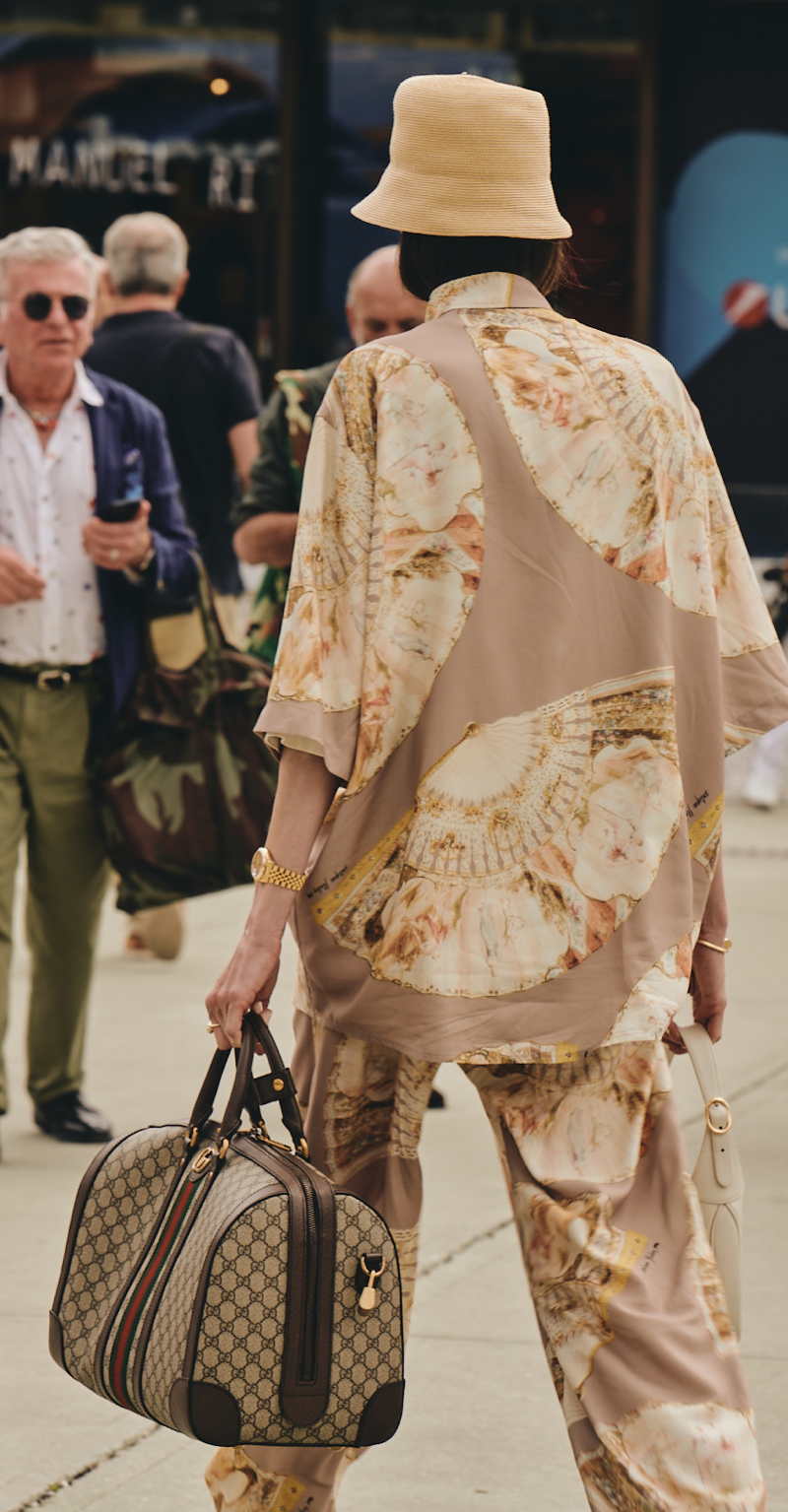

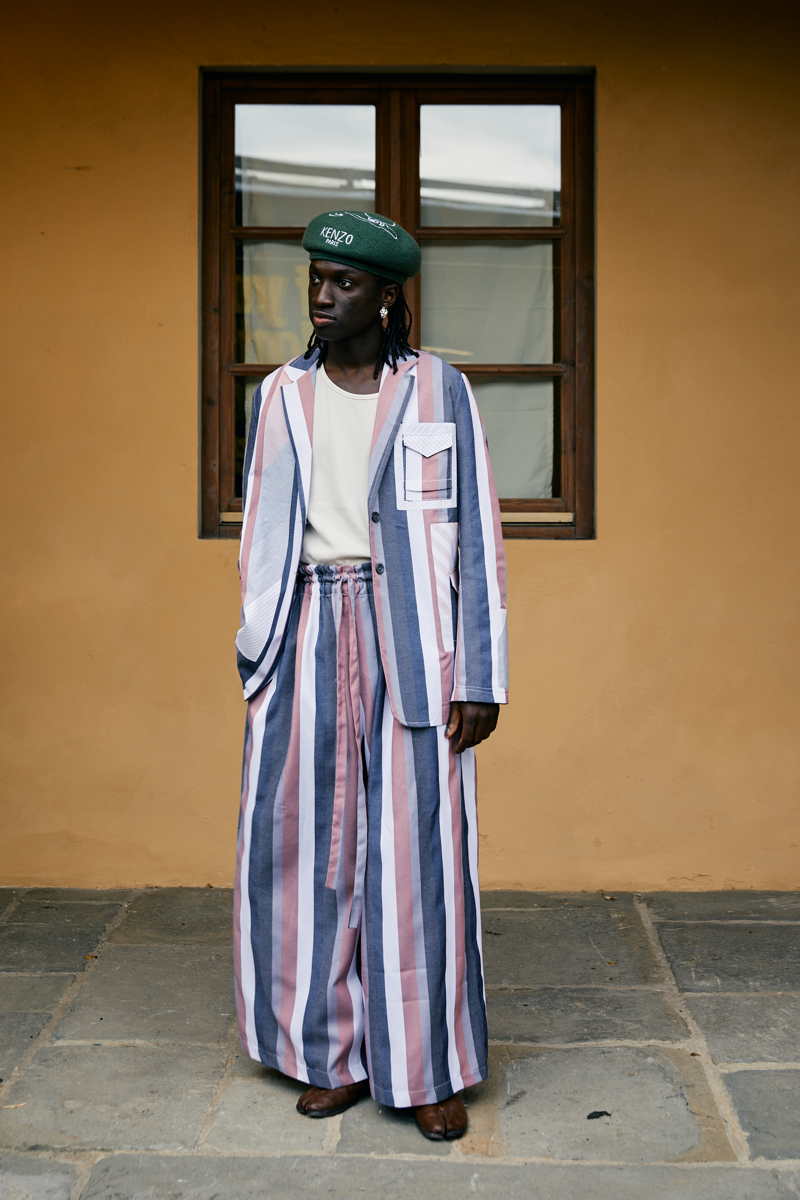
DEADSTOCKS AND INNOVATIVE TEXTILES AT S/STYLE’S COLLECTIONS
Crafting the future of menswear with 10 responsible collections, S/Style was the best area of the show to find avant-garde fashion, most of them made from deadstocks or sustainable innovative materiales provided by Kering Group. The platform, led by Giorgia Cantarini for promoting sustainable driven menswear, entered its seventh edition this summer with new strategic partner Kering Material Innovation Lab (Kering MIL), the group’s research center that focuses on progress in environmental responsibilities when producing. There we talked with Cavia, Dalpaos, Dhruv Kapoor, Isnurh, Jeanne Friot, Ksenia Schnaider, Olooh, Permu, Steven Passaro, young n sang to know more about the project and their new collections.
Nicola Dalpaos, from Dalpaos, explained us: “We normally focus on luxury upcycled materials to give them a new life and this collection is no exception but we always work to introduce also other responsible innovative and sustainable fabrics. For this collection Kering supported us with some very interesting innovation like the cork faux leather, one bio based materials made with the waste of the fruits and a denim made with a very low quantity of water considering the general standard, just to name few”. Dalpaos creates and produces most of the collections in Veneto region in Italy and this allows them to drastically contain the transport pollution.
Based in Paris, Jeanne Friot aims to redefine the concept of gender through a limited series of garments and a strong arts and crafts feeling. Previously part of the creative team of Balenciaga, Friot uses denim fabrics with recycled cotton content colored through an efficient yarn-dyeing technology.
“In Cavia our main value is to not produce anything for create the collection, but to reuse all the materials that are already on the market. In this collection, along yarns and fabrics, we used also vintage towels for create one of a kind Terry fleece items.” – says Martina Boero, founder and creative director of the upcycled fashion brand.
The Ukrainian brand Ksenia Schnaider is made from reworked and upcycled, patchwork, denim and accessories. The designers probe that be active players in the avant-garde denim niche creating asymetrical jeans, Demi-denim jeans, cowboy jeans and denim jackets that simulate the effect of fur.
Fearless self-expression, twisted modernity, and a strong emotional current come together to make the brand Dhruv Kapoor. Far from the traditional imaginary, this Delhi-based brand depicts an endless play of past, present and future. 40% of the collection incorporates discarded textiles from large Indian manufacturers. At the fair, Dhruv Kapoor introduced a collection made of organic cotton in intimate blend with viscose obtained from fiber-to-fiber chemical recycling process of cotton textile waste. Other fabrics used are recycled Nylon.
“Our spring summer 24 collection showcases meticulously crafted designs originating from our workshop in Copenhagen. By using a waterless cutting and printing process, we have embraced eco-friendly practices. Moreover, we take pride in utilizing biodegradable ink, further enhancing our commitment to sustainability. Notably, for our heavier designs, we have incorporated recycled fabrics and engaged in several captivating sourcing initiatives, including a look made in collaboration with Kering Group.” – says Kasper J. Todbjerg, Co-founder at ISNURH.
Young n sang is a menswear brand reconized for its innovative craft style. Each garments made using classical craft techniques in the atelier based on the use of vintage or reclaimed yarns. We loved the cashmere blended withe bioderived fibers produced through a fermentation process created from sugar and microorganisms.
Based in London, Permu embraces the individuality of spirit that does not adhere to gender codes. Classic lines are broken to accomplish the uniform of the future. The brand focuses on innovative cutting for patterns and a new sartorial technology using pure natural wool, silk, cotton and renewable wool like Italian Styblella and the British Scabal, 100% biodegradable and recyclable.

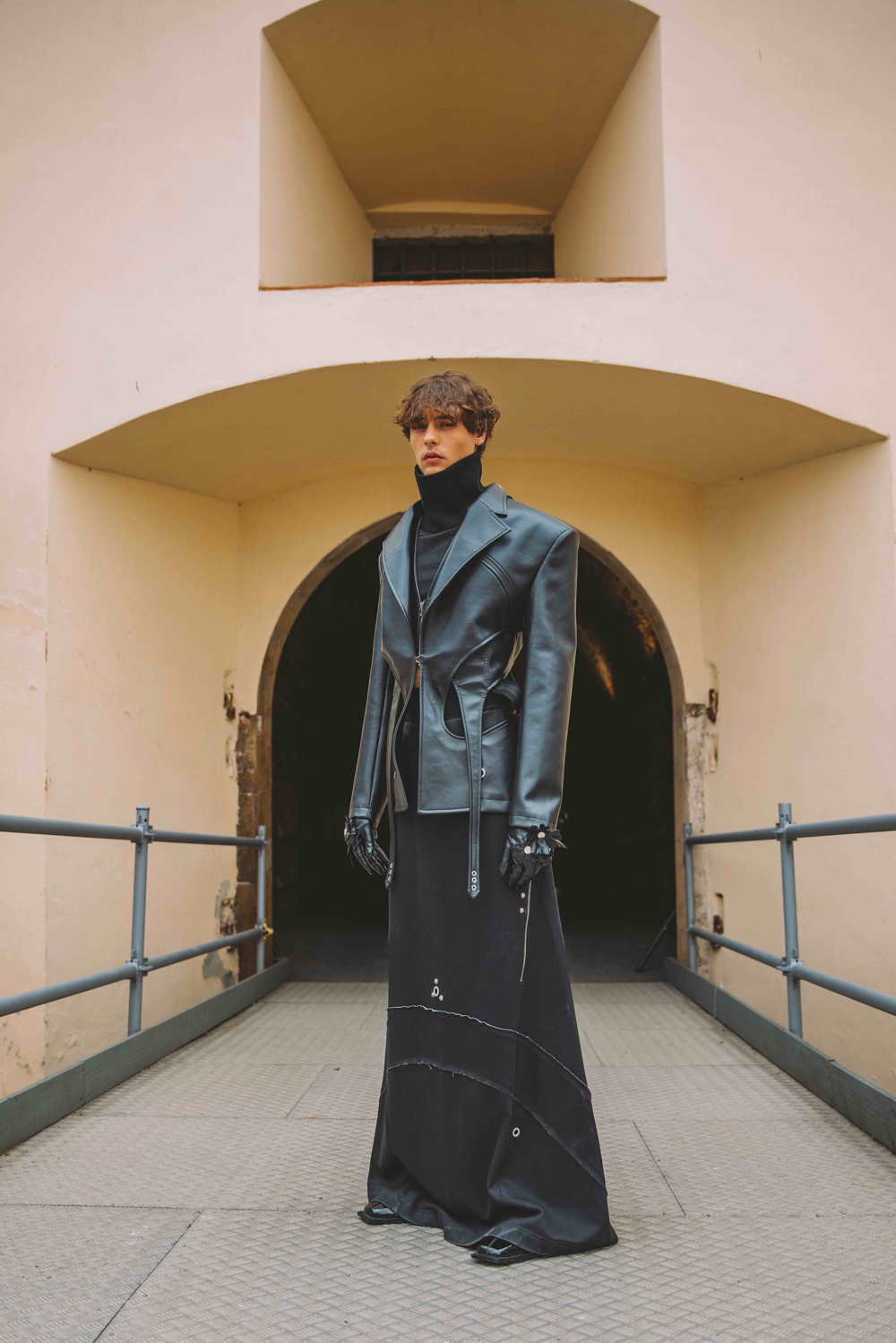




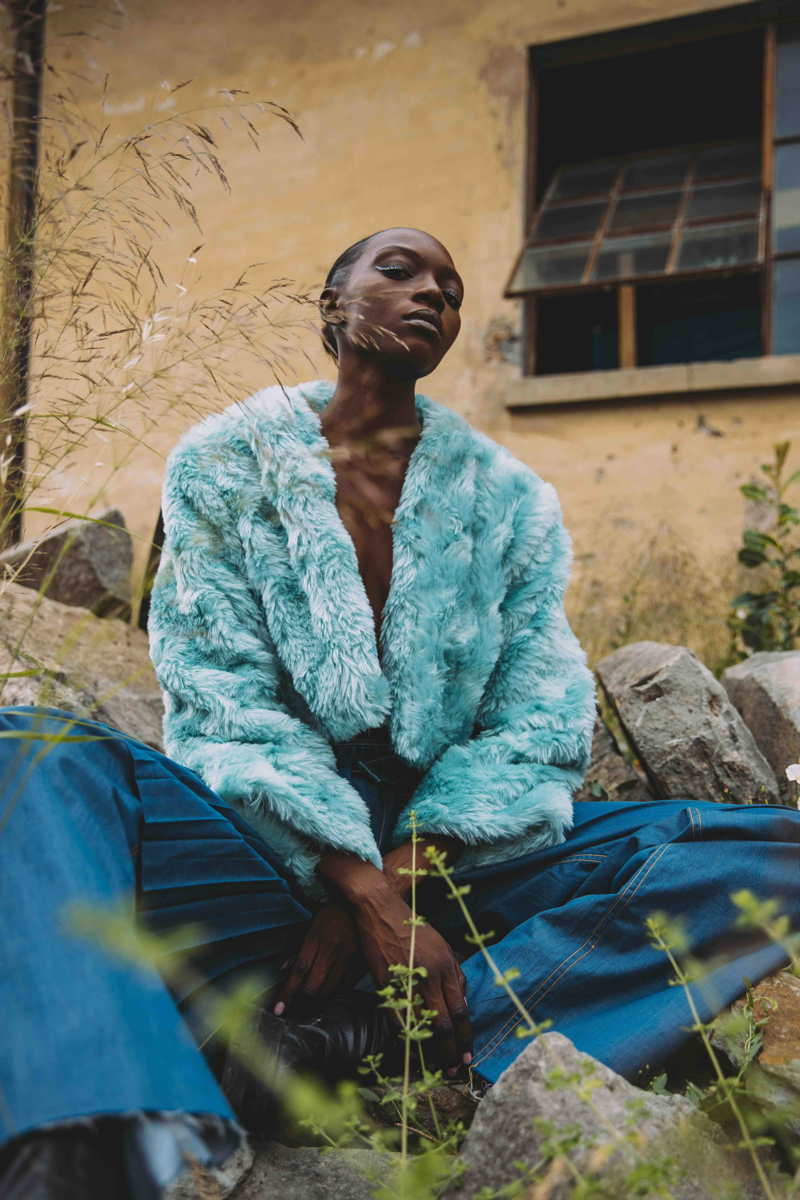


A SUSTAINABLE APPROACH IN OTHER AREAS
We also loved the new collection by Studio Seidensticker X Julian Daynov. “As with all our collections from Seidensticker and Studio Seidensticker, this capsule collection also paid great attention to the protection of the environment and the use of natural resources. Everything is produced sustainably and with materials that conserve resources.” – assures Julian Daynov.
From its own huge pavilion at the entrance of the fair, Ecoalf did not go unnoticed with its well-known and million times copied claim: “Because there is no planet B”. There the Spanish company invited us to discover the SS24 Lost Colors Collection, inspired by the Aral Sea, that today has become a desert as 90% of the water has disappeared as a result of unsustainable cotton cultivation. “With our SS23 collection we saved +17,6 billion liters of water and this 2024 season we plan to save even more” – says the brand -“We introduce t-shirts and sweatshirts made with 100% recycled cotton that reduces our water footprint by 98%, so one Ecoalf recycled cotton t-shirt can save 1,084 liters of water”.
Designer Chu Suwannapha – Thai by birth and South African by adoption, founder of the brand Chluaap, colored Pitti Uomo with a special installation in the Sala delle Nazioni. The label has earned a name for itself on the contemporary men’s fashion scene thanks to a captivating blend of colors, shapes, and textures. It is no accident that Suwannapha has been dubbed “Prince of Prints.” The creative power that comes from the designer’s background, combined with an innovative approach to combinations and shapes is a unique celebration of today’s Africa. Chluaap brings together traditions, techniques, and details from batik to origami to embroidery. Bold, broad, and squared lines create an experimental androgynous aesthetic that is projected towards the future.
We were surprised by the installation by Consinee, a company that sells 30% of cashmere market worldwide. The Chinese company, a leading player in the sustainable yarns manufacturing world, presents with Labelhood the caspules of a selection of cutting-edge designers, including Ponder.Er and Nullus from China and Luca Larenza from Italy, made with Consinee’s sustainable yarns.
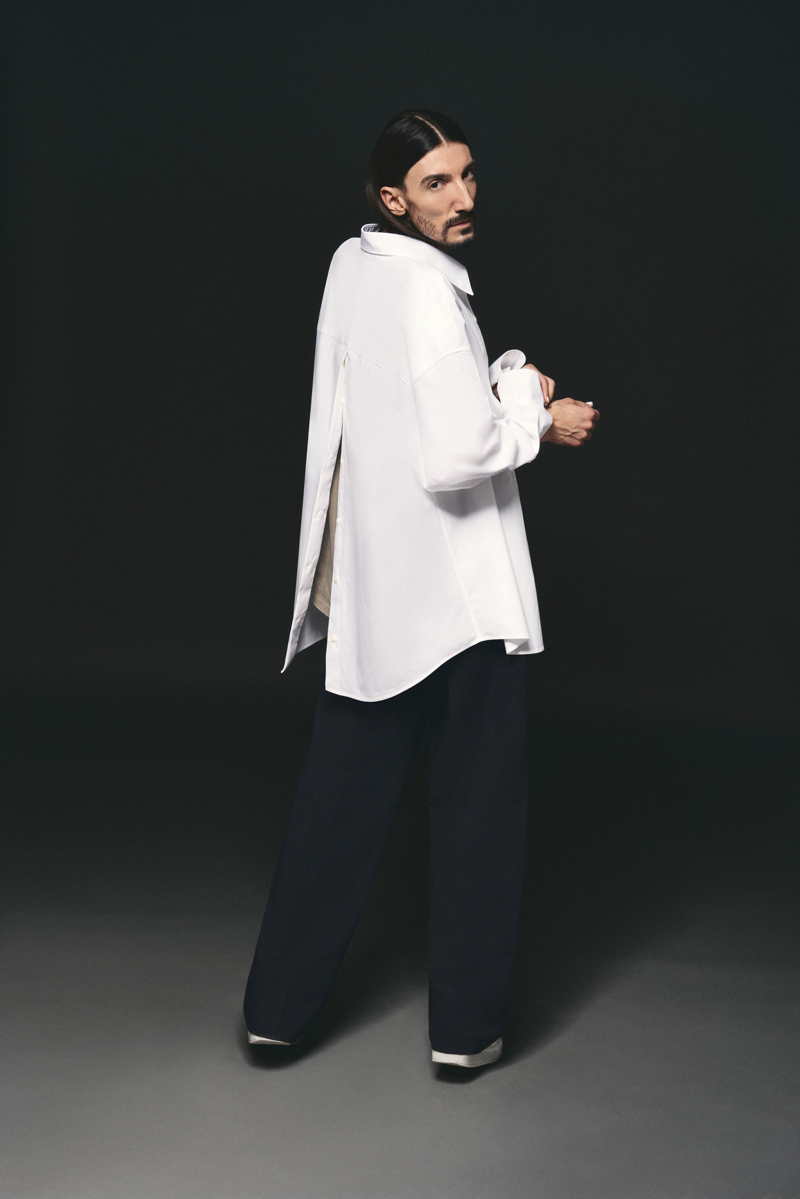

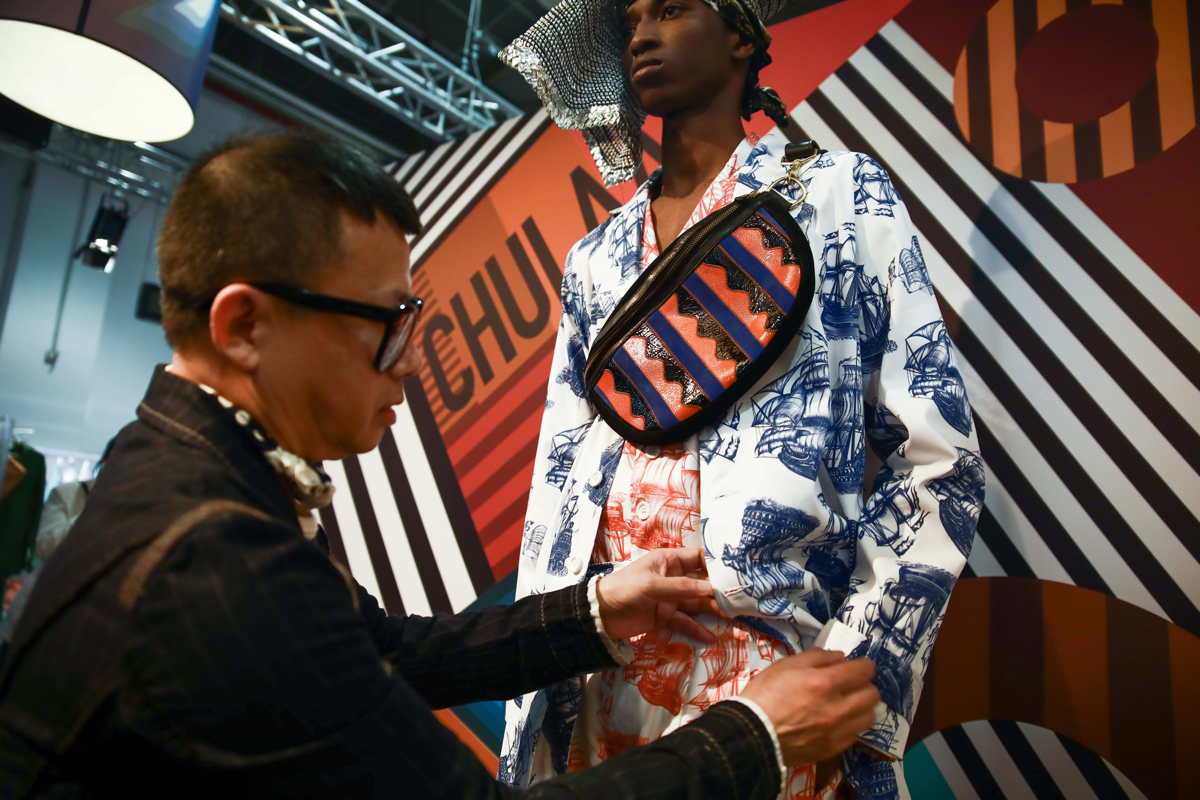
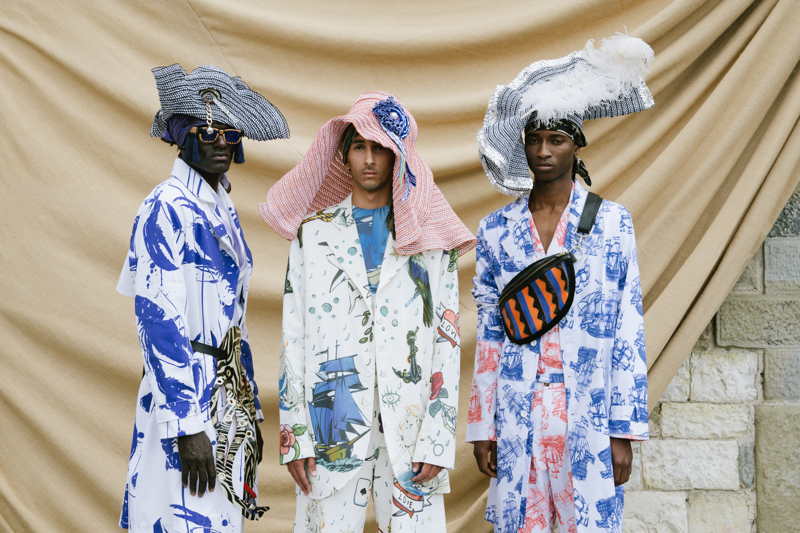

SECOND HAND & VINTAGE LOOKS AT PITTI UOMO
According to networking platform Cross Border Commerce, online trade of used clothing in the EU will reach 37 billons euros by 2025, a 37% increase over 2021. A survey by KPMG of 500 consumers shows that one in three can imagine wearing used clothes in the future. On the other hand, in the latest survey by Utopia, 41% of the almost 10.000 respondents say they want fashion companies to offer more reuse and return possibilities.
On the first floor of the Arsenale, the VINTAGE HUB Circular Fashion, curated by Angelo Caroli, the driving force behind A.N.G.E.L.O. presented ideas related to reselling, preloved items, and upcycling, combining fashion and design in a perspective that intertwines sustainability and business. The project was aimed at stores increasingly interested in hosting secondhand corners and vintage furnishings.
Also, Pitti Uomo presented Arsenale Live Shooting, a live styling/shooting event curated by fashion editor Giorgia Cantarini and photographer Giuseppe Triscari. They created looks that combine the proposals of a selection of brands from the Superstyling sections with garments and accessories from the Vintage Hub project.


ARE BUYERS INTERESTED ON SUSTAINABLE FASHION?
Martina Boero, from Cavia, thinks: “For sure buyers are interested in having sustainable collection in their stores, perhaps sometimes i think that also customers must be educated to this kind of collections, for make them understand the value behind the clothes. We are used to buy tshirts from 5 euro and a lot of people think that this is the right price, we need to eliminate these bad habits and recreate a fashion industry that is more ethical and creative.”
As Nicola Dalpaos, from Dalpaos, declared: “We had the chance to meet with several buyers during Pitti (…) I think buyers are seasonally more and more involved in searching and selecting sustainable brands but I believe there still is a long way to go, they look on their clients needs and I don’t think sustainability is something everyone are interesting about yet but still, every year the interest increase, more people are focused on it and is great to see how big brands works on improving their collections sustainability.”
“We have undoubtedly witnessed a surge in the appreciation for our designs, particularly due to the emphasis we place on sustainability. It is important to note that some buyers express concerns about the relatively higher price associated with sustainable designs. Nonetheless, the increasing interest in our offerings signifies a positive trend towards conscious and responsible fashion.” – says Kasper J. Todbjerg, Co-founder at ISNURH.
Carolina Alvarez-Ossorio, CMO at Ecoalf, has it clear: “Yes, of course. There is more and more interest in finding brands that share the values of customers, brands that do things differently and put the planet at the centre…” – she says.
At Seidensticker they are optimistic. As Julian Daynov says: “Yes and no since in the meantime, it becomes a necessity to at least consider sustainability within a corporate strategy and reflect this in the distinctive products. Nevertheless, our comprehensive approach, from raw material to production, packing and shipment, still stands out and creates a positive buzz.”
ARE CONSUMERS READY FOR BUYING SUSTAINABLE FASHION?
“The discourse surrounding sustainability in Copenhagen is gradually gaining momentum and resonating with consumers. However, it is essential to acknowledge that the Danish market remains heavily price-driven, with consumers often prioritizing discounts over sustainability considerations. Nonetheless, the emerging awareness and shifting perspectives indicate a promising future for sustainable practices in Denmark.” – declares Kasper J. Todbjerg, Co-founder at ISNURH.
As Nicola Dalpaos, from Dalpaos, declared: “I guess there are many people interested in knowing what they’re buying, looking to be sustainable and responsable with their purchases, and other who just wants to buy more, opting to get quantities instead of quality. Of course it can be a matter of costs, possibilities, but there are different options starting from vintage clothing untill the high end brands. Generally talking I would say the young generation is more focused and responsible. We’re going on the right way and the people is starting to understand how relevant is everyone’s choices.”
Julian Daynov, from Seidensticker, also see the light: “Definitely, German customers are paying more and more attention to the sustainability of a brand and the clothes when buying them. Above all, they are advocating a clear and transparent communication.”
In Italy, “is still thought that in the world in general there’s a lot of miscommunications and green washing, that’s why people still think that is sustainable buy something from the fast fashion market just because is made with a ‘biological’ material. But i think that there are generational problems, that’s why there’s must be also speeching and teaching in schools about this topic, because at least this is the world that we live in and everyone must be take care about it” – says Martina, founder of Cavia.
HOW SUCESSFUL WAS PITTI UOMO 104
We ask the brands to know it. “In a nutshell: a success! We saw high frequency of qualified international visitors on our stand with an overall positive resonance on the Seidensticker & Studio Seidensticker Collection. We spoke to retailers and buyers from all over Europe and overseas (Asia & Middle East)” – says Julian Daynov, from Seidensticker.
“The fair it was great especially in terms of press, there was a very cool crowd of journalists and fashion editors that were very interested in the collection.” – declares Martina, founder of Cavia.
“While participating in the S/style program, our presentation space at Pitti Uomo was limited, allowing us to exhibit only a fraction of our extensive collection of 55 pieces. Consequently, our expectations for business prospects from this event are modest. However, the exhibition offered a remarkable opportunity for influential visits, garnering substantial interest from buyers who have booked appointments to view the complete collection in Paris.” -declares Kasper J. Todbjerg, Co-founder at ISNURH.
Ecoalf, with its big booth at the entrance of the show, has another perception: “Pitti is a great fair to see and meet good clients from both the Italian and international market – to present our most innovative developments in terms of sustainability…” – declares Carolina Alvarez Osorio, CMO at the Spanish company.
Images:
© Pitti Immagine
Words:
Belvis Soler
Luxiders Magazine








